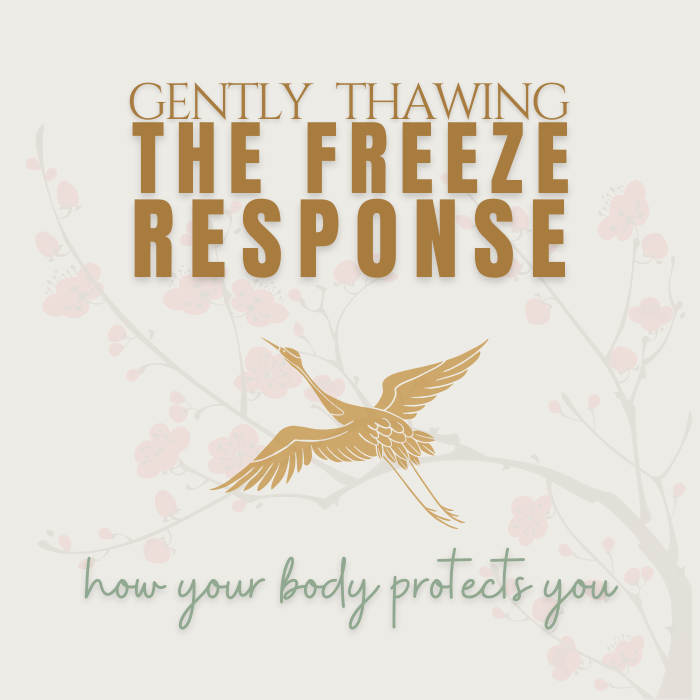How your body protects you — and how to thaw, gently
When people talk about trauma responses, most mention fight or flight.
But there’s another response — often quieter, more misunderstood, and just as powerful:
Freeze.
It’s the moment your body says:
“This is too much. I can’t fight. I can’t run. I will disappear instead.”
Freeze isn’t weakness.
It’s wisdom — a protective pause when nothing else feels possible.
Some links on this page are affiliate links. If you choose to purchase through them, it supports this site at no extra cost to you. Thank you for your support. 🤍
What Is the Freeze Response?
Freeze is the nervous system’s way of self-protecting in the face of overwhelm.
It’s not chosen consciously. It happens automatically.
It can look like:
- Going emotionally numb
- Mentally checking out
- Feeling paralyzed, unable to move or speak
- “Spacing out” during stress
- Shutting down after an argument
- Going blank in a triggering situation
- Losing access to words, memory, or decision-making
For some, it’s a momentary pause.
For others, it becomes a long-term state of disconnection.
Why It Happens
Freeze is often the result of earlier life experiences where:
- Expressing fear wasn’t safe
- You had no power to escape
- You learned to endure silently
- Being small or invisible protected you
- You were overwhelmed emotionally, physically, or relationally
Your body decided:
“Let’s numb this. Let’s pause until it’s safe again.”
And so it did.
Brilliantly. Intelligently. Quietly.
If you’d like a deeper understanding of how the freeze trauma response works — and how to gently support it — this trauma overview from NICABM offers compassionate insight from leading practitioners.
How Freeze Can Affect Daily Life
Even long after the danger has passed, the freeze response may linger.
You might notice:
- Difficulty starting tasks
- Chronic fatigue or apathy
- Emotional numbness or detachment
- Feeling overwhelmed by simple decisions
- Feeling like you’re “on the outside” of your own life
- Knowing you want to change something… but feeling frozen when you try
This isn’t laziness.
It’s your nervous system trying to keep you safe 🪷
Gently Working With the Freeze Response
Healing from freeze doesn’t mean “snapping out of it.”
It means slowly building enough inner safety for your system to thaw.
Start with:
Gentle Sensory Awareness
Touch something soft.
Notice temperature.
Wiggle your toes.
Let your body know, “I’m here.”
Micro-Movements
Instead of pushing, allow tiny movements — rolling your shoulders, stretching your hands.
Rhythmic Sound or Breath
Soft humming, music, or sighing can help gently bring rhythm back into your system.
Co-Regulation
Being with someone grounded can help your system feel safe enough to shift out of freeze.
Slowness
Honor your pace. Thawing a frozen system takes time, not force.
If you’re gently working with the freeze trauma response, these two resources may support your healing — especially if reading feels hard or your system needs extra softness:
• Healing Trauma by Peter Levine
A short, accessible guide (with audio) for softening trauma held in the body. Ideal when you feel frozen, disconnected, or unsure how to begin. No pressure — just breath and small openings.
• The Polyvagal Flip Chart by Deb Dana
A visual companion for understanding your nervous system’s cues. Especially helpful when words feel far away, and your body needs quiet, clear support.
🌿 FAQ
Is freeze the same as dissociation?
They’re related but not identical. Freeze is a survival response that may include dissociation — a protective mental distance from what’s overwhelming. Both serve as forms of protection and can soften with time and support.
Why do I shut down in situations that aren’t “that bad”?
Your body remembers past overwhelm, even if your mind says, “I’m fine.” Healing helps your nervous system update — so present-moment safety becomes felt, not just thought.
Next Steps That Might Support You
- Softening the Fight-or-Flight Response
- Grounding Practices to Calm the Nervous System
- What Is Nervous System Dysregulation?
- Listening to the Body’s Quiet Signals
You don’t need to rush.
~You don’t need to push.
You only need to begin, gently.
Your unfolding is already underway — and it’s beautiful.

